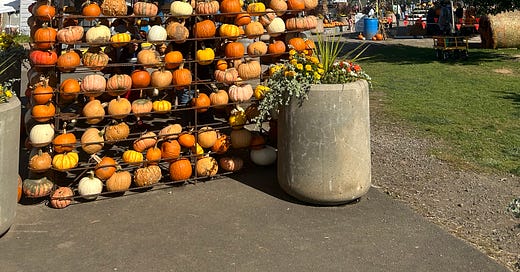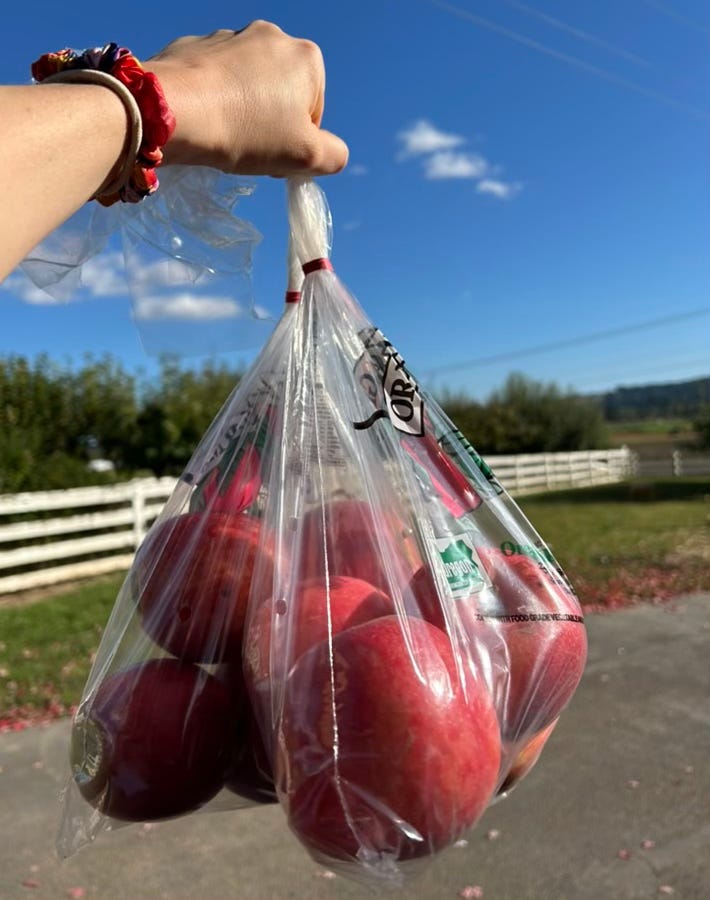Fall is officially here! October is the perfect month - we get the best of both worlds. We’re getting crisper mornings + nights but still spoiled by the sunshine during the day. We’ll have some rainy, moody days sprinkled in. Fall baking seems to lift everyone’s spirits despite the drop in sunshine. I hope this month’s newsletter has a synonymous boost to your spirit as fall baking, crunchy fall leaves, and pumpkin patches do.
Fresh Fall


Ways to use herbs + spices this fall:
— ginger in a stir fry
— marinating meat with all the herbs! it provides a freshness to a dish and so much flavor
— homemade bread with fresh herbs
— cinnamon in smoothies, oatmeal, baked goods
— ginger + fresh herbs in bone both
— saffron latte
EAT
October mood board
— pumpkin curry
— fall baking (see next section for inspo)
— homemade spaghetti sauce with the last of the tomatoes
— cornbread with chili
— [dirty] chai tea latte
— potential October intentions: Pumpkin patch. Football weekends with friends + food. The first fire in the fireplace of the season. Go for a scenic drive to see all of the leaves changing. Apple Picking. Watching WNBA finals. PSLs. Crispy, fall runs.



What I’m cooking
Breakfast:
Tahini Chai Breakfast Cookies - these are calling my name
Pumpkin and Oat Breakfast Bars
Everything Bacon and Apple Breakfast Biscuits
Dinner:
Tomato Soup (df)
Fall Charcuterie Board (for hosting, warmer nights, or no cook nights)
Fall Pizzas (4 Ways)
Drinks:
Pear Vanilla Rosemary Cocktail
Sparkling Fig & Honey Cocktail
Dessert:
Apple Spice Loaf (df, can be made vegan)
Pumpkin Chocolate Chip Cookie Skillet (v)
Additional ideas:
Fall Menu coming next week!
For Each Season’s ‘Fall Recipes’ Pinterest Board
LISTEN
When you want moody, walking on crunchy leaves, falling asleep to the rain, crisp air mornings with sunny day vibes.
Fall Playlist:
Nutrition & Brain Health
— This is an interesting podcast discussing brain health. Before discussing, please note: all health suggestions + interventions should be taken with a grain of salt. I encourage everyone to do their own research, even on suggestions and statements I make. An example of a claim I do not agree with in this podcast, the guest began to portray gluten as having a negative association with brain health, but research isn’t conclusive on that relationship. In fact, foods containing gluten often have high levels of vitamin B - a group of vitamins later discussed in this same podcast to be largely impactful for brain health. Part of the guest’s argument against gluten was because gluten is such a widespread crop, and more often than not, farmers are using glyphosate to keep crop supply up with demand. There is a clear harm to brain health in research from glyphosate consumption due to the connection between brain health and gut health. Research suggests glyphosate negatively perturbs the gut microbiome. When the gut is damaged, nutrients aren’t absorbed as well. As B vitamin absorption is diminished when the gut lining is damaged, this directly impacts brain health. Another factor causing significant brain degeneration include inflammation - this can stem from food intake, lack of sleep, abnormal amounts of prolonged stress, or a combination of the aforementioned.
— Boost Brain Health: some of the dietary recommendations discussed in this podcast include avoiding GMO foods, increasing dietary fiber, and bumping up plant variety to nurture the gut microbiome. Lifestyle recommendations are incorporating aerobic exercise as it is associated with as much as a 50% reduction in suffering from dementia and sleeping - not only good for the soul but good for brain health. When listening to this podcast, I was reminded of a statistic I learned in grad school that I will never forget: Our lifestyle choices directly impact the expression of our genome; research shows that our genetic expression is affected as quickly as 4-6 hours from dietary + lifestyle choices.
— The thing that I always find humorous when discussing brain health, hormone health, gut health, etc. is that the “solutions” are almost always the same — eat healthy (don’t eat crap, eat real food, eat yo plants), exercise (a combination of cardio + resistance training), take care of your mental health, and prioritize sleep. These are all things positively impacting brain health but are also associated with improved CV health, reduction in diabetes or increased insulin sensitivity, reduction of some forms of cancer, improved skin health, better sleep, regulated hormone levels, better bone density - the list goes on! HOW IRONIC. Don’t get sucked into the marketing schemes on social media. We can all do our best in this season of life to take care of ourselves, in every sense of the phrase, when focusing on the same building blocks. Rant over.
READ
Vitamin D O’Clock
Fall is the time of year where I encourage clients, especially those who live in higher latitude states, to start taking a Vitamin D supplement. Researchers have discovered that residents living in Boston and more north create no vitamin D from November to February. As we get less sun exposure going into the fall + winter months, we want to supplement Vitamin D for a variety of reasons, including mood.1 Vitamin D regulates 1) bone mineralization23, 2) blood calcium homeostasis, 3) impacts immune health45, 4) may play a role in insulin secretion6, and acts as a hormone.7
— Recommended dosages: for those of us farther up north, research recommends at least 600 IU/day; there are nuances depending on where you live, your baseline vitamin D levels, and how quickly you metabolize vitamin D. A daily supplement recommendation could be up to 10,000 IU/day.
— Sources: When we are lacking sunshine, our skin isn’t able to synthesize as much ultraviolet light. Sources of vitamin D include fatty/oily fish, fortified milk (plant + animal based), eggs, liver meats, and butter.
SLEEP
As we start creeping our way into the hibernation months, these are some tips + tricks that I’ve curated over the years to help stabilize sleep schedules during fall + winter.
— Keep things consistent: try to keep your same wake up/bed time despite it being darker. Keep that body on the same schedule.
— Have something to look forward to: what will help get you out of bed during those dark mornings? A walk with your dog(s), significant other, and/or friend? Workout class? Cup of coffee? Quiet morning to yourself? Remind yourself of that when the alarm clock goes off.
— Get outside: with the limited sunshine coming our way, get outside when the sun is out (even if it is grey + cloudy)! Get some sun exposure on your lunch breaks, take a pause when walking to your car before/after work, or picking your kids up. Look up and get those eyes + brain some UV exposure to help regulate sleep. Even the brightest house lights pale in comparison to sunshine on a cloudy day. Nothing can do better than Mother Nature.
REFLECT
“Just as God has birthed rhythm/seasons into nature, He has birthed rhythm/seasons into our lives.”
— Reflecting and recognizing seasons in my own life and friend’s lives that challenge us, grow us, shape us, and ultimately prepare us for future seasons.
[Going] Back Home, an excerpt.
— Flooded with nostalgia. Recognized unlearned + learned patterns. Saw cousins you haven’t seen in months/years but automatically feel at home with. OG restaurants that taste like home. Old bed but your new self. Felt at home again.
“The things we take for granted, someone else is praying for.”
— Life is a funny thing. We always want more, always have goals, often want the newest x, y, or z. Todd and I have gone through years of multiple rough financial seasons, yet as we make our way out of the haze, we find ourselves still wanting more. While I don’t think this innate desire is unhealthy or bad per se — although I do think the modern age doesn’t help — I do think it often blinds us to what we have now. Things we are able to do or buy where at one point, there was no room in the budget for those or we’d be stressing wondering where that money would be coming from. While I think this concept spans outside of financial circumstances, I do think it makes a strong argument for us to sit back + reflect. Outside of research showing that gratitude improves longevity, I think it improves your attitude toward the world and what you have. Whatever that may look like for you - relationships you prayer for, finances you needed, a new car you could never afford, community you longed for, a job you desperately wanted, etc. Remember + reflect on what you used to long for that you now have. Let’s be a little more grateful this month, friends.
COMING SOON
— apple crumble recipe!
— fall menu; I hope it helps you guys get the most out of each season, introduces you to new produce to try, and gets you excited about cooking.
— hydration guide coming soon to Substack [for paid subscribers]. An early edition was accidentally sent out [oops, that was me] and unfortunately still needed revising, so that has been taken down for the time being.
— London city guide coming in September or October to Substack [for paid subscribers]
Enough from me!
Making the most of each season,
Mads
Anglin, R. E., Samaan, Z., Walter, S. D., & McDonald, S. D. (2013). Vitamin D deficiency and depression in adults: systematic review and meta-analysis. British Journal of Psychiatry, 202, 100–107. https://pubmed.ncbi.nlm.nih.gov/23377209/
Charoenngam, N., Rujirachun, P., Holick, M. F., & Ungprasert, P. (2019). Oral vitamin D3 supplementation increases serum fibroblast growth factor 23 concentration in vitamin D-deficient patients: a systematic review and meta-analysis. Osteoporosis International, 30(11), 2183–2193. https://pubmed.ncbi.nlm.nih.gov/31372708/
Bischoff-Ferrari, H. A., Willett, W. C., Wong, J. B., Giocannucci, E., Dietrich, T., & Dawson-Hughes, B. (2005). Fracture prevention with vitamin D supplementation: a meta-analysis of randomized controlled trials. Jama, 293(18), 2257–64. https://pubmed.ncbi.nlm.nih.gov/15886381/
Giusti, A., Barone, A., Pioli, G., Girasole, G., Razzano, M., Pizzonia, M., Pedrazzoni, M., Palummeri, E., & Bianchi, G. (2010). Heterogeneity in serum 25-hydroxy-vitamin D response to cholecalciferol in elderly women with secondary hyperparathyroidism and vitamin D deficiency. Journal of the American Geriatric Society, 58(8), 1489–1495. https://pubmed.ncbi.nlm.nih.gov/20646099/
Merlino, L. A., Curtis, J., Mikuls, T. R., Cerhan, J. R., Criswell, L. A., & Saag, K. G. (2004). Vitamin D intake is inversely associated with rheumatoid arthritis: results from the Iowa Women's Health Study. Arthritis & Rheumatology, 50(1), 72–77. https://pubmed.ncbi.nlm.nih.gov/14730601/
Kampmann, U., Mosekilde, L., Juhl, C., Moller, N., Christensen, B., Rejnmark, L., Wamberg, L., & Orskov, L. (2014). Effects of 12 weeks high dose vitamin D3 treatment on insulin sensitivity, beta cell function, and metabolic markers in patients with type 2 diabetes and vitamin D insufficiency - a double-blind, randomized, placebo-controlled trial. Metabolism, 63(9), 1115–1124. https://pubmed.ncbi.nlm.nih.gov/25044176/
Outila, T. A., Kärkkäinen, M. U., Seppänen, R. H., & Lamberg-Allardt, C. J. (2000). Dietary intake of vitamin D in premenopausal, healthy vegans was insufficient to maintain concentrations of serum 25-hydroxyvitamin D and intact parathyroid hormone within normal ranges during the winter in Finland. Journal of the American Dietetic Association, 100(4) https://pubmed.ncbi.nlm.nih.gov/10767899/





